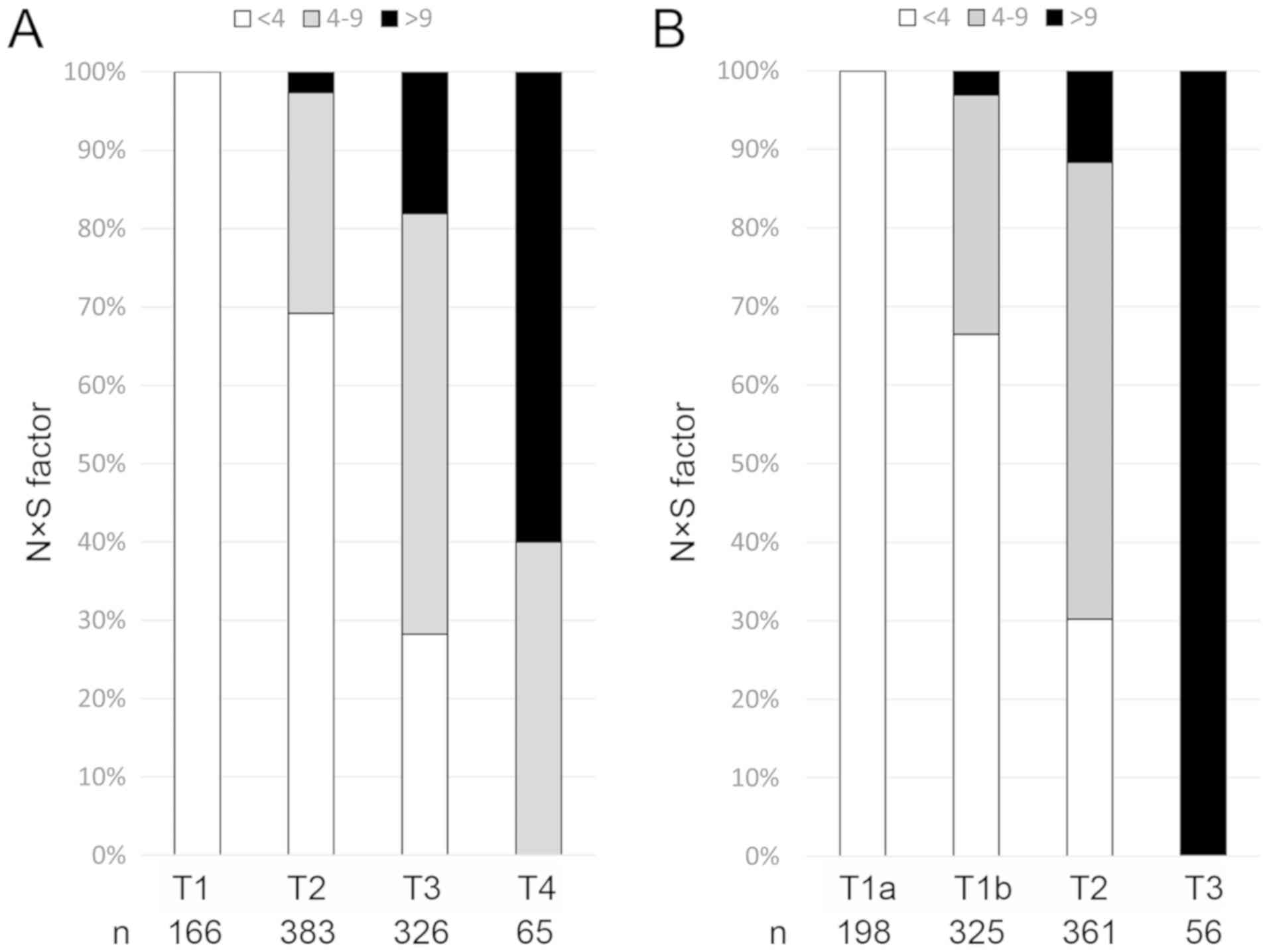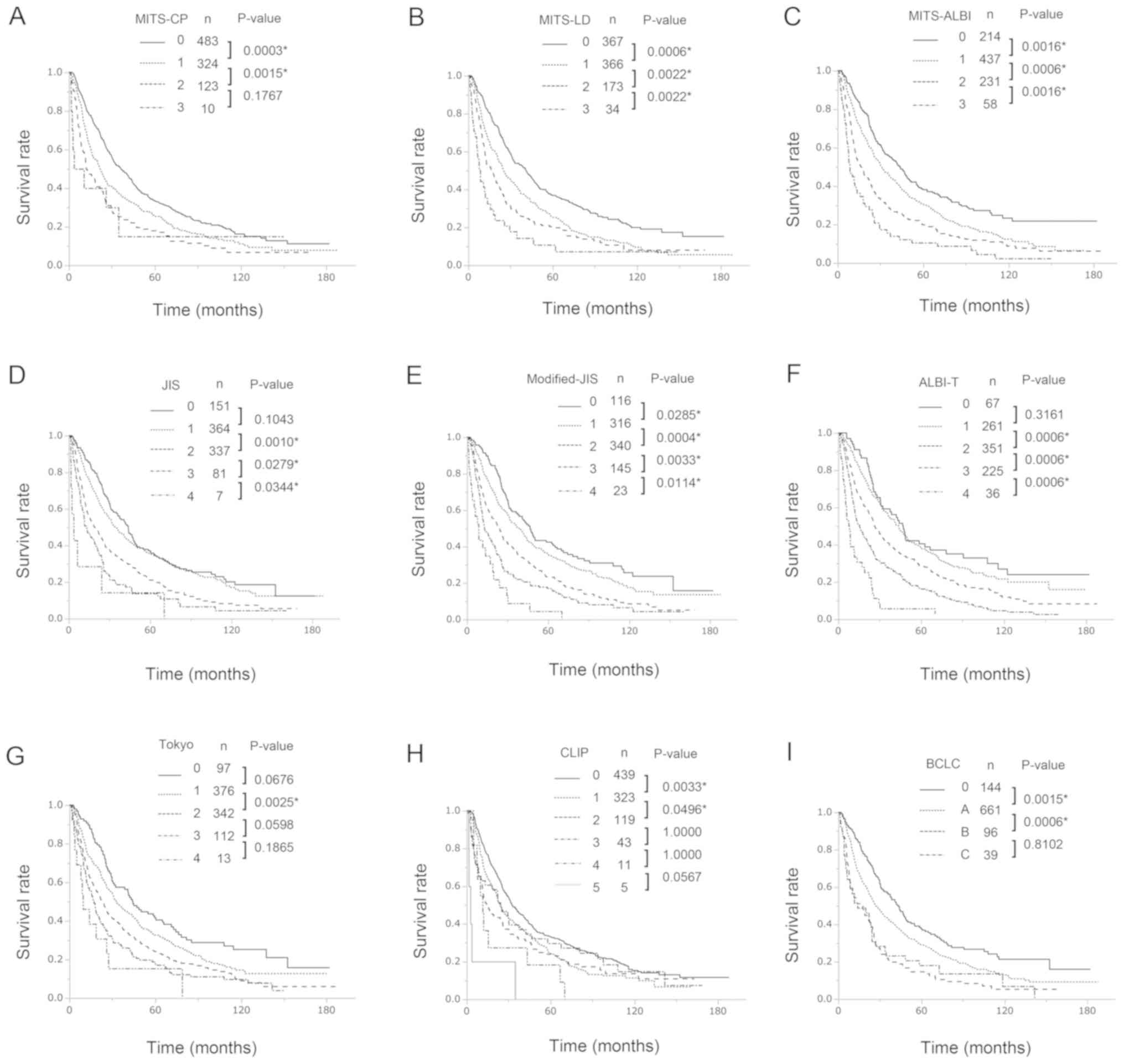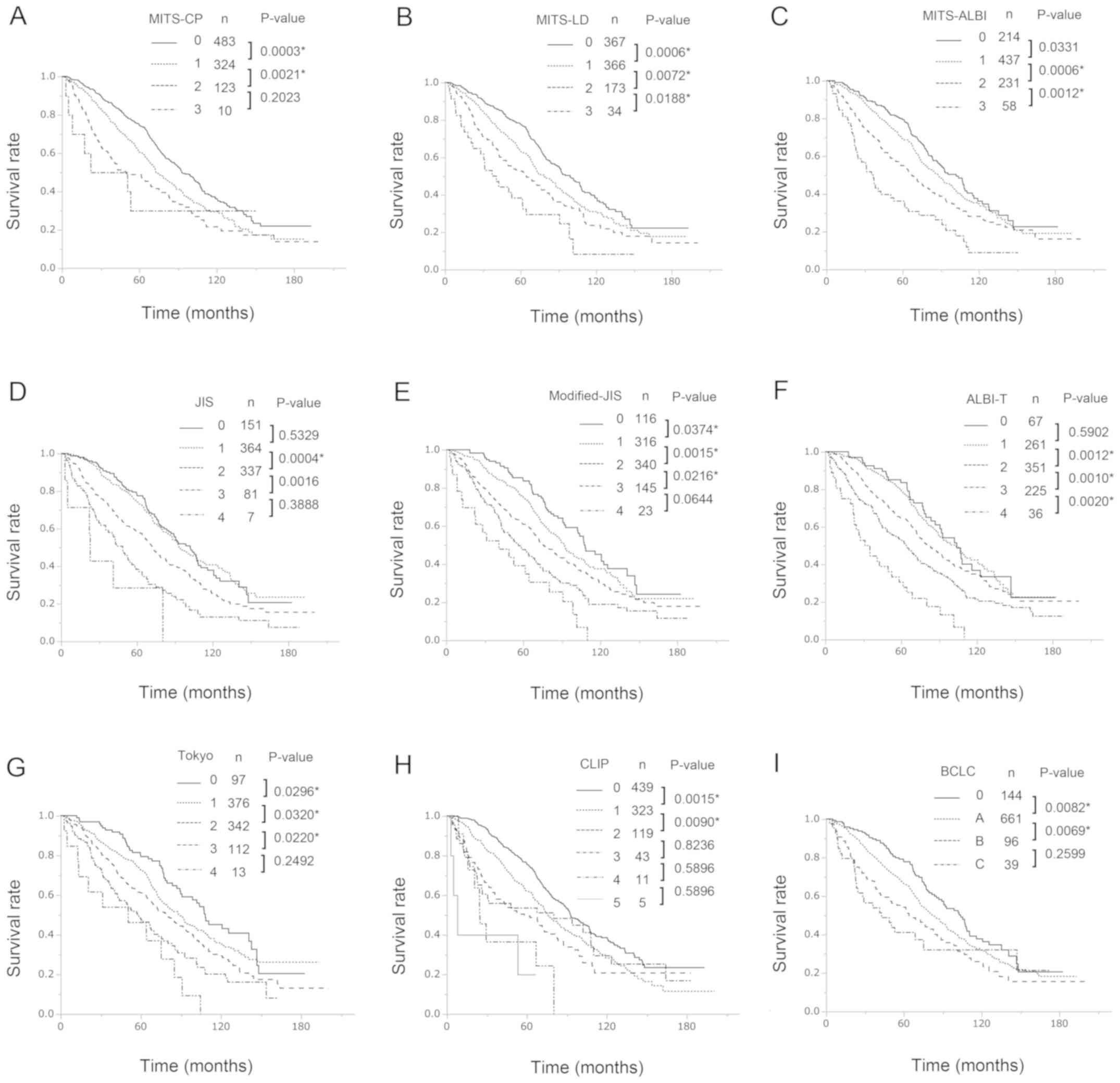|
1
|
Forner A, Llovet JM and Bruix J:
Hepatocellular carcinoma. Lancet. 379:1245–1255. 2012. View Article : Google Scholar : PubMed/NCBI
|
|
2
|
Torre LA, Bray F, Siegel RL, Ferlay J,
Lortet-Tieulent J and Jemal A: Global cancer statistics, 2012. CA
Cancer J Clin. 65:87–108. 2015. View Article : Google Scholar : PubMed/NCBI
|
|
3
|
Colvin H, Mizushima T, Eguchi H, Takiguchi
S, Doki Y and Mori M: Gastroenterological surgery in Japan: The
past, the present and the future. Ann Gastroenterol Surg. 1:5–10.
2017. View Article : Google Scholar : PubMed/NCBI
|
|
4
|
Kakeji Y, Takahashi A, Udagawa H, Unno M,
Endo I, Kunisaki C, Taketomi A, Tangoku A, Masaki T, Marubashi S,
et al: Surgical outcomes in gastroenterological surgery in Japan:
Report of national clinical database 2011–2016. Ann Gastroenterol
Surg. 2:37–54. 2017. View Article : Google Scholar : PubMed/NCBI
|
|
5
|
Henderson JM, Sherman M, Tavill A,
Abecassis M, Chejfec G and Gramlich T: AHPBA/AJCC consensus
conference on staging of hepatocellular carcinoma: consensus
statement. HPB (Oxford). 5:243–250. 2003. View Article : Google Scholar : PubMed/NCBI
|
|
6
|
Llovet JM, Ricci S, Mazzaferro V, Hilgard
P, Gane E, Blanc JF, de Oliveira AC, Santoro A, Raoul JL, Forner A,
et al: Sorafenib in advanced hepatocellular carcinoma. N Engl J
Med. 359:378–390. 2008. View Article : Google Scholar : PubMed/NCBI
|
|
7
|
Kudo M, Finn RS, Qin S, Han KH, Ikeda K,
Piscaglia F, Baron A, Park JW, Han G, Jassem J, et al: Lenvatinib
versus sorafenib in first-line treatment of patients with
unresectable hepatocellular carcinoma: A randomised phase 3
non-inferiority trial. Lancet. 391:1163–1173. 2018. View Article : Google Scholar : PubMed/NCBI
|
|
8
|
Hazama S, Tamada K, Yamaguchi Y, Kawakami
Y and Nagano H: Current status of immunotherapy against
gastrointestinal cancers and its biomarkers: Perspective for
precision immunotherapy. Ann Gastroenterol Surg. 2:289–303. 2018.
View Article : Google Scholar : PubMed/NCBI
|
|
9
|
Kudo M, Chung H and Osaki Y: Prognostic
staging system for hepatocellular carcinoma (CLIP score): Its value
and limitations, and a proposal for a new staging system, the Japan
integrated staging score (JIS score). J Gastroenterol. 38:207–215.
2003. View Article : Google Scholar : PubMed/NCBI
|
|
10
|
Nanashima A, Sumida Y, Morino S, Yamaguchi
H, Tanaka K, Shibasaki S, Ide N, Sawai T, Yasutake T, Nakagoe T and
Nagayasu T: The Japanese integrated staging score using liver
damage grade for hepatocellular carcinoma in patients after
hepatectomy. Eur J Surg Oncol. 30:765–770. 2004. View Article : Google Scholar : PubMed/NCBI
|
|
11
|
Harimoto N, Yoshizumi T, Sakata K, Nagatsu
A, Motomura T, Itoh S, Harada N, Ikegami T, Uchiyama H, Soejima Y
and Maehara Y: Prognostic significance of combined
albumin-bilirubin and tumor-node-metastasis staging system in
patients who underwent hepatic resection for hepatocellular
carcinoma. Hepatol Res. 47:1289–1298. 2017. View Article : Google Scholar : PubMed/NCBI
|
|
12
|
Prospective validation of the CLIP score,
. A new prognostic system for patients with cirrhosis and
hepatocellular carcinoma: The Cancer of the Liver Italian Program
(CLIP) investigators. Hepatology. 31:840–845. 2000. View Article : Google Scholar : PubMed/NCBI
|
|
13
|
Tateishi R, Yoshida H, Shiina S, Imamura
H, Hasegawa K, Teratani T, Obi S, Sato S, Koike Y, Fujishima T, et
al: Proposal of a new prognostic model for hepatocellular
carcinoma: An analysis of 403 patients. Gut. 54:419–425. 2005.
View Article : Google Scholar : PubMed/NCBI
|
|
14
|
Llovet JM, Bru C and Bruix J: Prognosis of
hepatocellular carcinoma: The BCLC staging classification. Semin
Liver Dis. 19:329–338. 1999. View Article : Google Scholar : PubMed/NCBI
|
|
15
|
Arii S, Sata M, Sakamoto M, Shimada M,
Kumada T, Shiina S, Yamashita T, Kokudo N, Tanaka M, Takayama T and
Kudo M: Management of hepatocellular carcinoma: Report of consensus
meeting in the 45th annual meeting of the Japan society of
hepatology (2009). Hepatol Res. 40:667–685. 2010. View Article : Google Scholar : PubMed/NCBI
|
|
16
|
Yau T, Tang VY, Yao TJ, Fan ST, Lo CM and
Poon RT: Development of hong kong liver cancer staging system with
treatment stratification for patients with hepatocellular
carcinoma. Gastroenterology. 146:1691–1700. 2014. View Article : Google Scholar : PubMed/NCBI
|
|
17
|
Pons F, Varela M and Llovet JM: Staging
systems in hepatocellular carcinoma. HPB (Oxford). 7:35–41. 2005.
View Article : Google Scholar : PubMed/NCBI
|
|
18
|
Tokumitsu Y and Nagano H: Current HCC
staging systems: Their uses and limitations. Hepatocellular
Carcinoma: Diagnosis and treatment. Carr BI: Springer; Basel: pp.
425–442. 2016, View Article : Google Scholar
|
|
19
|
Tokumitsu Y, Tamesa T, Matsukuma S,
Hashimoto N, Maeda Y, Tokuhisa Y, Sakamoto K, Ueno T, Hazama S,
Ogihara H, et al: An accurate prognostic staging system for
hepatocellular carcinoma patients after curative hepatectomy. Int J
Oncol. 46:944–952. 2015. View Article : Google Scholar : PubMed/NCBI
|
|
20
|
Kokudo N, Hasegawa K, Akahane M, Igaki H,
Izumi N, Ichida T, Uemoto S, Kaneko S, Kawasaki S, Ku Y, et al:
Evidence-based clinical practice guidelines for hepatocellular
carcinoma: The Japan Society of Hepatology 2013 update (3rd JSH-HCC
Guidelines). Hepatol Res. 45:124642015. View Article : Google Scholar
|
|
21
|
Pugh RN, Murray-Lyon IM, Dawson JL,
Pietroni MC and Williams R: Transection of the oesophagus for
bleeding oesophageal varices. Br J Surg. 60:646–649. 1973.
View Article : Google Scholar : PubMed/NCBI
|
|
22
|
The general rules for the clinical and
pathological study of primary liver cancer. Kanehara; Tokyo: pp.
7–41. 2010
|
|
23
|
Johnson PJ, Berhane S, Kagebayashi C,
Satomura S, Teng M, Reeves HL, O'Beirne J, Fox R, Skowronska A,
Palmer D, et al: Assessment of liver function in patients with
hepatocellular carcinoma: A new evidence-based approach-the ALBI
grade. J Clin Oncol. 33:550–558. 2015. View Article : Google Scholar : PubMed/NCBI
|
|
24
|
Mazzaferro V, Regalia E, Doci R, Andreola
S, Pulvirenti A, Bozzetti F, Montalto F, Ammatuna M, Morabito A and
Gennari L: Liver transplantation for the treatment of small
hepatocellular carcinomas in patients with cirrhosis. N Engl J Med.
334:693–699. 1996. View Article : Google Scholar : PubMed/NCBI
|
|
25
|
Tokumitsu Y, Sakamoto K, Tokuhisa Y,
Matsui H, Matsukuma S, Maeda Y, Sakata K, Wada H, Eguchi H, Ogihara
H, et al: A new prognostic model for hepatocellular carcinoma
recurrence after curative hepatectomy. Oncol Lett. 15:4411–4422.
2018.PubMed/NCBI
|
|
26
|
Mazzaferro V: Results of liver
transplantation: With or without milan criteria? Liver Transpl 13
(11 Suppl 2). S44–S47. 2007. View
Article : Google Scholar
|
|
27
|
Mazzaferro V, Llovet JM, Miceli R, Bhoori
S, Schiavo M, Mariani L, Camerini T, Roayaie S, Schwartz ME, Grazi
GL, et al: Predicting survival after liver transplantation in
patients with hepatocellular carcinoma beyond the Milan criteria: A
retrospective, exploratory analysis. Lancet Oncol. 10:35–43. 2009.
View Article : Google Scholar : PubMed/NCBI
|
|
28
|
Hsu CY, Huang YH, Hsia CY, Su CW, Lin HC,
Loong CC, Chiou YY, Chiang JH, Lee PC, Huo TI and Lee SD: A new
prognostic model for hepatocellular carcinoma based on total tumor
volume: The taipei integrated scoring system. J Hepatol.
53:108–117. 2010. View Article : Google Scholar : PubMed/NCBI
|
|
29
|
Kim BK, Han KH, Park YN, Park MS, Kim KS,
Choi JS, Moon BS, Chon CY, Moon YM and Ahn SH: Prediction of
microvascular invasion before curative resection of hepatocellular
carcinoma. J Surg Oncol. 97:246–252. 2008. View Article : Google Scholar : PubMed/NCBI
|
|
30
|
Yamashita YI, Imai K, Yusa T, Nakao Y,
Kitano Y, Nakagawa S, Okabe H, Chikamoto A, Ishiko T, Yoshizumi T,
et al: Microvascular invasion of single small hepatocellular
carcinoma </=3 cm: Predictors and optimal treatments. Ann
Gastroenterol Surg. 2:197–203. 2018. View Article : Google Scholar : PubMed/NCBI
|
|
31
|
Brierley JD, Gospodarowicz MK and
Wittekind C: TNM Classification of Malignant Tumours. 8th.
Wiley-Blackwell; pp. 80–82. 2017
|
|
32
|
Wakabayashi H, Ishimura K, Izuishi K,
Karasawa Y and Maeta H: Evaluation of liver function for hepatic
resection for hepatocellular carcinoma in the liver with damaged
parenchyma. J Surg Res. 116:248–252. 2004. View Article : Google Scholar : PubMed/NCBI
|
|
33
|
Hiraoka A, Kumada T, Michitaka K, Toyoda
H, Tada T, Ueki H, Kaneto M, Aibiki T, Okudaira T, Kawakami T, et
al: Usefulness of albumin-bilirubin grade for evaluation of
prognosis of 2584 Japanese patients with hepatocellular carcinoma.
J Gastroenterol Hepatol. 31:1031–1036. 2016. View Article : Google Scholar : PubMed/NCBI
|
|
34
|
Llovet JM, Burroughs A and Bruix J:
Hepatocellular carcinoma. Lancet. 362:1907–1917. 2003. View Article : Google Scholar : PubMed/NCBI
|
|
35
|
Adachi E, Maeda T, Matsumata T, Shirabe K,
Kinukawa N, Sugimachi K and Tsuneyoshi M: Risk factors for
intrahepatic recurrence in human small hepatocellular carcinoma.
Gastroenterology. 108:768–775. 1995. View Article : Google Scholar : PubMed/NCBI
|
|
36
|
Ikeda K, Saitoh S, Tsubota A, Arase Y,
Chayama K, Kumada H, Watanabe G and Tsurumaru M: Risk factors for
tumor recurrence and prognosis after curative resection of
hepatocellular carcinoma. Cancer. 71:19–25. 1993. View Article : Google Scholar : PubMed/NCBI
|
|
37
|
Gao M, Nettles RE, Belema M, Snyder LB,
Nguyen VN, Fridell RA, Serrano-Wu MH, Langley DR, Sun JH, O'Boyle
DR II, et al: Chemical genetics strategy identifies an HCV NS5A
inhibitor with a potent clinical effect. Nature. 465:96–100. 2010.
View Article : Google Scholar : PubMed/NCBI
|

















